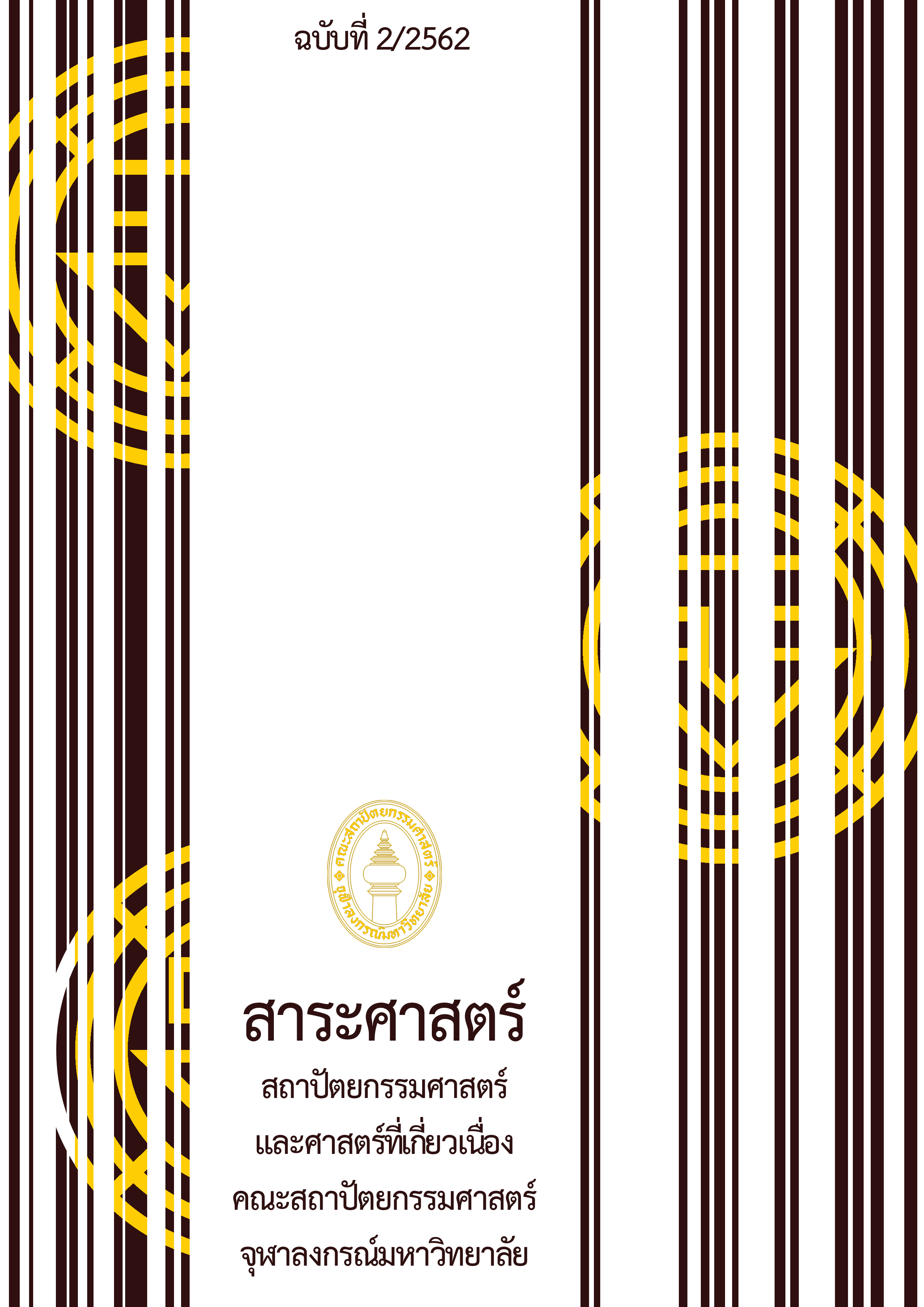Flood Pulse Dynamics and Ecosystem Services of Chaophraya Delta A Case Study of Ladchado Community Amphoe Pukhai Ayutthaya Province A CASE STUDY OF LADCHADO COMMUNITY AMPHOE PUKHAI AYUTTHAYA PROVINCE
Main Article Content
Abstract
Flood pulse dynamics is seasonal fluctuation and a major influence on the landscape of Chaophraya delta. Its geomorphic and fluvial processes had been created flood pulsing landscape characteristic and produced ecological productivity richness. The rural community of Ladchado has been co-evolve and benefits on direct and non-direct ecological services provided by flood pulse as resources for basic needs, trading in rural economic system. Developments without carefully concerning its environmental issues have been caused inevitably impacts on natural dynamics, ecological services and rural livelihood.
The objectives of the research are to clarify flood pulsing dynamics and ecosystem services in
Chaophraya delta and to investigate how rural benefits from ecological services. Research methods are 1) Analyzing flood pulse dynamics boundary with geographic information system (GIS). 2) Interviewing local people in order to collect examples of ecological productivities. The result indicates that ecological services produced by flood pulse dynamics are the essential basis for rural economy development, especially, products of deep water rice and fish. These resources are significant to food subsistence and human well-being. But disconnecting of the river and its delta has been disrupted flood pulse cycle. Without flood pulse dynamics, ecological services are declining in both quantity and quality. These effects rural livelihood of Ladchado community who rely upon natural resources. By decreasing food sources, living expenses are getting more expensive while traditional rice farmer and fisherman are disappearing and self-reliance for a household is declined.
Article Details
References
Bayley, P. “The Flood Pulse Advantage and The Restoration of River-Floodplain Systems.” Regulated Rivers: Research&Management 6 (1991): 75-86.
Bayley, P. B., and Sparks, R. E. “The Flood Pulse Concept in River-Floodplain Systems.” The Canadian Journal of Fisheries and Aquatic Sciences (1989): 110-127.
Castello, L., Issac, V. J., and Thapa, R. “Flood Pulse Effects on Multispecies Fisher Yields in the Lower
Amazon.” Royal Society Open Science 2, 11 (2015 November): 150299.
Catling, D. Rice in Deep Water. London: The Macmillan Press, 1992.
Chavalit Vidthayanon. Checklists of Freshwater Fishes in Thailand. Bangkok: Office of Natural Resources and Environmental Policy and Planning, 2017.
ESRI. “World Imagery [Basemap].” Accessed March 15, 2019. https://www.arcgis.com/home/item.html?id.
FAO. The State of the World’s Biodiversity for Food and Agriculture. Rome: Commission on Genetic
Resources for Food andAgriculture Food and Agriculture Organization of the United States, 2019.
Haruyama, S. “Geomorphology of the Central Plain of Thailand and its Relationship with Recent Flood Conditions.” GeoJournal 31,4 (1993): 327-334.
Junk, W. J. The Central Amazon Floodplain. New York: Springer-Verlag Berlin Heidelberg GmbH, 1997.
Kaida, Y. A. “Pioneer Settlements and Water Control Development on the West Bank of the Lower Chao Phraya Delta: Water Conditions in the Deltaic Lowland Rice Fields (II).” Southest Asian Studies 11, 4 (1974): 512-524.
Kaida, Y. A.“Subdivision of the Chao Phraya Delta in Thailand Based on Hydrographical Conditions: Water Condition in Deltaic Lowland Rice Fields(I).” Southest Asian Studies 11, 3 (1973): 403-413.
Molle, F. and Jesda Keawkulaya. “Water Management and Agricultural Chang: A Case Study in the Upper
Chao Phraya Delta.” Southest Asian Studies 36,1 (1998): 32-58.
Mondal, P. Productivity of Ecosystem: Primary, Secondary and Net Productivity. Accessed May 5, 2019. https://www.yourarticlelibrary.com/environment/ecosystem/productivity-of-ecosystem-primary-secondary-and-net-productivity/23274.
Sinsakul, Sin. “Late Quaternary Geology of the Lower Central Plain, Thailand.” Journal of Asian Earth Sciences 18 (2000): 415-426.
Tanabe, S. “Farming Technology in the Deep Flooding Area of the Chao Phraya Delta: A Case Study in Ayutthaya.” Southest Asian Studies 17, 4 (1980): 658-707.
Tanaka, W., Wattanasiriserekul, R., Tomiyama, Y., Yamasita, T., Phinrub, W., Chamnivikaipong, T. and Shimatani, Y. “Influence of Floodplain Area on Fish Species Richness in Waterbodies of the Chao Phraya River Basin, Thailand.” Open Journal of Ecology 5 (2015): 434-451.
Tomosugi, T. Changing Features of a Rice Growing Village in Central Thailand: A Fixed-Point Study from 1967-1993. Tokyo: Kokusai Media, 1995.
Wittmer, H., Berghofer, A., Forster, J., and Almack, K. “The Value of Nature for Local Development. In The Economics of Ecosystems and Biodiversity for Local and Regional Policy Makers: UNEP TEEB.” Accessed March 15, 2019. https://www.environment.gov.za/sites/default/files/docs/economicsof_ecosystems_valueofnature.pdf.
จารุวรรณ ขำเพชร, อดิศร เสมแย้ม, วรรณรัตน์ รัตนวรางค์, ถวัลย์ ภูวัลย์, อนุพันธ์ คำปันและพงษ์ศักดิ์ ขำเพชร. โครงการสายนํ้า: สายชีวิตและวัฒนธรรมคนริมนํ้า. กรุงเทพฯ: สำนักงานการวิจัย, 2554.
ฉัตรทิพย์ นาถสุภา. เศรษฐกิจหมู่บ้านไทยในอดีต. พิมพ์ครั้งที่ 5. กรุงเทพฯ: สร้างสรรค์, 2550.
ตรงใจ หุตางกูร. “การตีความใหม่เรื่องขอบเขตแนวชายฝั่งทะเลโบราณสมัยทวารวดีบนที่ราบภาคกลางตอนล่าง.” วารสารดำรงวิชาการ 13, 1 (2557): 11-44.
ตำราเทคโนโลยีอวกาศและภูมิสารสนเทศศาสตร์. กรุงเทพฯ: สำนักงานพัฒนาเทคโนโลยีอวกาศและภูมิสารสนเทศและสมาคมสำรวจข้อมูลระยะไกลและสารสนเทศภูมิศาสตร์แห่งประเทศไทย, 2552.
วิทยากร เชียงกูล. เศรษฐกิจระบบนิเวศ เพื่อโลกที่เป็นธรรมและยั่งยืน. กรุงเทพมหานคร: บ้านพระอาทิตย์, 2554.
ศูนย์อุทกวิทยาชลประทานภาคกลาง. “รายงานสภาพน้ำท่า ภาคกลาง (2555-2561).” สืบค้น 31 มีนาคม 2562.
Hydro-5.com/report/wl_week.php.
สุวิทย์ ธีรศาศวัต. ประวัติศาสตร์เทคโนโลยีการเกษตร. พิมพ์ครั้งที่ 1. กรุงเทพมหานคร: มติชน, 2548.
อรุณ จิรวัฒน์กุล. การออกแบบแบบสอบถามสำหรับงานวิจัย. พิมพ์ครั้งที่ 1. กรุงเทพฯ: วิทยพัฒน์, 2556.


